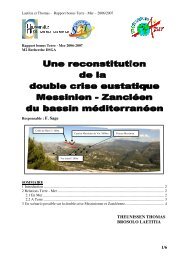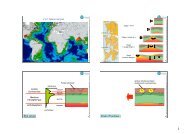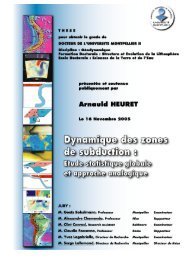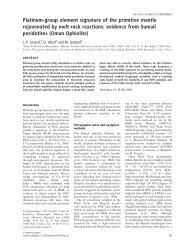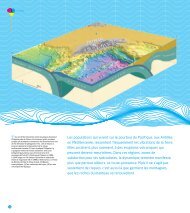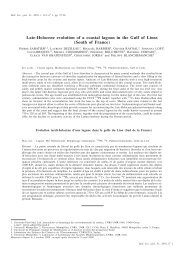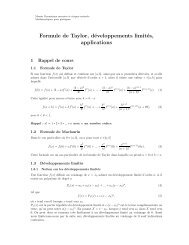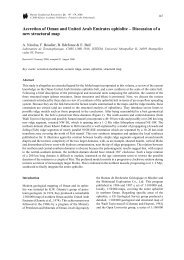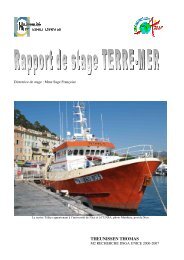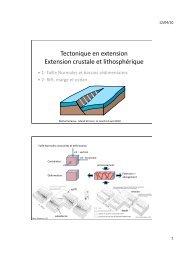Géochronologie U-Pb par ablation laser et ICP-MS (LA-ICP-MS ...
Géochronologie U-Pb par ablation laser et ICP-MS (LA-ICP-MS ...
Géochronologie U-Pb par ablation laser et ICP-MS (LA-ICP-MS ...
You also want an ePaper? Increase the reach of your titles
YUMPU automatically turns print PDFs into web optimized ePapers that Google loves.
U–<strong>Pb</strong> Silurian age for a gabbro of the Platinum-bearing Belt of the Middle<br />
Urals (Russia): evidence for beginning of closure of the Uralian Ocean<br />
DELPHINE BOSCH 1 , OLIVIER BRUGUIER 2 , ALEXANDER A. EFIMOV 3 & ARTHUR A. KRASNOBAYEV 3<br />
1 Laboratoire de Tectonophysique, Université de Montpellier II, UMR 5568-CNRS/UMII, Place E. Bataillon,<br />
34095 Montpellier Cedex 05, France (e-mail: bosch@dstu.univ-montp2.fr)<br />
2 Service <strong>ICP</strong>-<strong>MS</strong>, ISTEEM, Université de Montpellier II, Place E. Bataillon,<br />
34095 Montpellier Cedex 05, France<br />
3 Institute of Geology and Geochemistry, Pochtovyi Pereuloic 7, Ekaterinburg 620151, Russia<br />
Abstract: The Platinum-bearing Belt of the Urals consists of a series of zoned ultramafic bodies obducted onto the passive continental<br />
margin of the East European Craton during the Palaeozoic. Conventional U–<strong>Pb</strong> and secondary ionization mass spectrom<strong>et</strong>ry U–Th–<strong>Pb</strong><br />
analyses of single zircon grains from a pegmatitic gabbro of the Kumba massif provide Mid-Silurian ages of 425 + 3 Ma and<br />
419 + 10 Ma, respectively, interpr<strong>et</strong>ed as dating crystallization of the gabbroic magma. This contrasts with the c. 360 Ma age of the<br />
neighbouring Kytlym massif and indicates that the Uralian Platinum-bearing Belt is best interpr<strong>et</strong>ed as remnants of an island-arc<br />
oceanic lithosphere that started forming in Mid-Silurian times and had a protracted lif<strong>et</strong>ime of about 70 Ma. The Uralian Platinumbearing<br />
Belt is thus coeval with the Sakmara arc of the Southern Urals, and is of similar age to other ultramafic bodies such as the<br />
Kempersai and Mindyak massifs. Ophiolitic fragments, now preserved along the Main Uralian Fault, may thus represent the assemblage<br />
of contemporaneous oceanic and arc terranes brought tog<strong>et</strong>her during the final stages of the evolution of the Uralide orogen. The age of<br />
the Kumba massif, in addition, indicates that the Uralian Ocean underwent contractional events as early as the Mid-Silurian, which<br />
suggests a possible link with the pivotal rotation of Baltica.<br />
The convergence of the East European Craton (EEC) and the<br />
Siberian–Kazakhstan terrane assemblage that ultimately led to<br />
the formation of the Urals mountain belt at the end of the<br />
Palaeozoic was preceded by closing of the Uralian Ocean that se<strong>par</strong>ated<br />
the various continental masses. Remnants of oceanic lithosphere<br />
that became trapped along the suture b<strong>et</strong>ween the colliding<br />
continents provide important time markers for the pre-collisional<br />
history of the orogen. Ophiolite complexes are numerous in the<br />
Urals (Savelieva & Nesbitt 1996) and crop out in the hanging<br />
wall of the Main Uralian Fault (MUF), the main suture zone that<br />
runs the entire length of the mountain belt (Matte 1995). These<br />
massifs appear as lens-shaped bodies mainly of lherzolitic<br />
and harzburgitic composition elongated <strong>par</strong>allel to the MUF<br />
(Savelieva <strong>et</strong> al. 1997). The continuity of the belt and similar<br />
structural position of the massifs (i.e. allochthonous position overlying<br />
either the Precambrian basement or Palaeozoic sediments of<br />
the EEC margin) suggest a common origin. However, whereas<br />
some massifs show a nearly compl<strong>et</strong>e p<strong>et</strong>rological association<br />
typical of ophiolite sequences, others lack the upper gabbro,<br />
she<strong>et</strong>ed dyke and lava complexes, and crop out as zoned plutons<br />
of mafic–ultramafic rocks. Thus, it is unclear wh<strong>et</strong>her the<br />
c. 2000 km long oceanic terrane exposed in the Urals represents<br />
fragments of a single extensive dismembered ophiolite (where,<br />
in some cases, the upper lava complexes have been removed by<br />
tectonic processes) or wh<strong>et</strong>her some massifs are remnants of<br />
island-arc terranes derived from the Uralian Ocean and progressively<br />
telescoped with the EEC margin. Despite their importance<br />
in understanding the evolution and destruction of the Uralian<br />
Ocean and thus the earliest evolutionary stages of the Uralide<br />
Orogen, isotopic age information is s<strong>par</strong>se on these complexes.<br />
Most of our knowledge is from a few isotopic datings on Alaskantype<br />
zoned mafic–ultramafic complexes located in the Uralian<br />
Platinum-bearing Belt (UPB; Ivanov & Kaleganov 1993;<br />
Bea <strong>et</strong> al. 2001; Ronkin <strong>et</strong> al. 2003), and from typical ophiolitic<br />
massifs displaying well-developed plutonic and volcanic units,<br />
such as the Kempersai (Southern Urals) and Voykar massif<br />
(Polar Urals) (Edwards & Wasserburg 1985; Sharma <strong>et</strong> al. 1995;<br />
Melcher <strong>et</strong> al. 1999). In this study, we present conventional<br />
U–<strong>Pb</strong> single-zircon analyses and U–Th–<strong>Pb</strong> in situ secondary ionization<br />
mass spectrom<strong>et</strong>ry (SI<strong>MS</strong>) analyses for a pegmatitic<br />
gabbro of the Kumba massif, which crops out in the Uralian<br />
Platinum-bearing Belt. The significance of these results is discussed<br />
in relation to the available isotopic data from other<br />
massifs in the Platinum-bearing Belt and from other occurrences<br />
along the Main Uralian Fault in an attempt to understand the<br />
evolution of the Uralian Ocean.<br />
Geological s<strong>et</strong>ting<br />
The Uralian Platinum-bearing Belt (UPB) forms a giant structure<br />
exposed in the Central and Northern Urals (see Fig. 1a). It is<br />
located east of the MUF where the suture sector widens and is characterized<br />
by the abundance of zoned mafic–ultramafic complexes.<br />
These massifs are similar to Alaskan-type complexes (Irvine 1967)<br />
and show the typical association dunite–clinopyroxenite–gabbro<br />
(DCG units of Fershtater <strong>et</strong> al. 1997). The UPB consists of a series<br />
of 13 rounded to elongated massifs forming a discontinuous but<br />
linear elongated zone, which crops out for a distance of about<br />
900 km (Fig. 1a). The mafic–ultramafic bodies are associated with<br />
rocks of the Tagil Zone, which consists of Early Ordovician to<br />
Early Silurian volcanic and volcano-sedimentary units, tectonically<br />
associated with shelf-facies and continental-slope deposits.<br />
They commonly developed a thermal aureole in the volcanosedimentary<br />
sequences (Savelieva & Nesbitt 1996). The massifs<br />
are mainly composed of gabbros (olivine gabbros, gabbro–norites,<br />
clinopyroxene–hornblende gabbros), and also of clinopyroxenites,<br />
wehrlites, dunites, pegmatitic gabbros and plagiogranites (Fig. 1b)<br />
with a progressive magma differentiation from dunite through wehrlite–clinopyroxenite<br />
to gabbro. Sharp compositional changes of rock<br />
associations suggest that intrusions were pulsating (Savelieva <strong>et</strong> al.<br />
1999). In the study region, field relationships indicate a complex<br />
allochthonous association with at least two main nappe systems.<br />
Structurally lower units consist of Late Ordovician to Early Silurian<br />
deposits of palaeo-oceanic affinities (greenstone basalts, m<strong>et</strong>acherts,<br />
psammitic and pelitic tuffs, along with tectonized relics of possibly<br />
Ordovician ophiolites), whereas the structurally upper system is<br />
composed of a stack of tectonic slices. These are composed of<br />
volcano-sedimentary and volcaniclastic terrigenous units of Late<br />
Ordovician to Early Silurian age in contact with and ap<strong>par</strong>ently<br />
From: GEE, D.G.&STEPHENSON, R. A. (eds) 2006. European Lithosphere Dynamics.<br />
Geological Soci<strong>et</strong>y, London, Memoirs, 32, 443–448. 0435-4052/06/$15.00 # The Geological Soci<strong>et</strong>y of London 2006. 443



